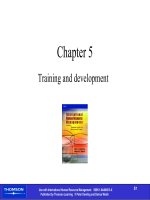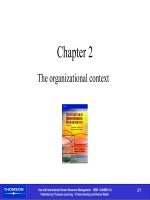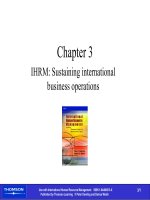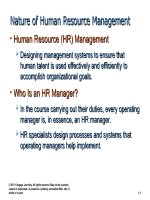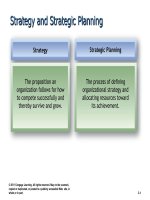Ch05 international human resource management cengage
Bạn đang xem bản rút gọn của tài liệu. Xem và tải ngay bản đầy đủ của tài liệu tại đây (685.13 KB, 18 trang )
Purpose of HR Planning
Effective HR
Planning
Right
people
Right
capabilities
© 2011 Cengage Learning. All rights reserved. May not be scanned,
copied or duplicated, or posted to a publicly accessible Web site, in
whole or in part.
Right
times
Right
places
5–1
Assessing the External Workforce
External Workforce
Economic and
Governmental
Factors
Competitive
Evaluations
© 2011 Cengage Learning. All rights reserved. May not be scanned,
copied or duplicated, or posted to a publicly accessible Web site, in
whole or in part.
Changing
Workforce
Considerations
5–2
Forecasting HR Supply and Demand
• Forecasting
Using information from the past and the present to
identify expected future conditions.
• Types of Forecasts
HR Demand
Internal Supply
External Supply
• Forecasting Periods
Short-term—less than one year
Intermediate—up to five years
Long-range—more than five years
© 2011 Cengage Learning. All rights reserved. May not be scanned,
copied or duplicated, or posted to a publicly accessible Web site, in
whole or in part.
5–3
Individual/Organizational Relationships
• The Psychological Contract
The unwritten expectations employees and employers
have about the nature of their work relationships.
Affected by age of employee and changes in
economic conditions.
Focuses on expectations about “fairness” that may
not be defined clearly by employees.
• Psychological Ownership
When individuals feel that they have some control and
perceived rights in the organization, they are more
likely to be committed to the organization.
© 2011 Cengage Learning. All rights reserved. May not be scanned,
copied or duplicated, or posted to a publicly accessible Web site, in
whole or in part.
5–4
Components of the Psychological Contract
Employers provide:
Employees contribute:
• Competitive compensation
and benefits
• Continuous skill improvement
and increased productivity
• Flexibility to balance work
and home life
• Reasonable time with the
organization
• Career development
opportunities
• Extra efforts and results when
needed
© 2011 Cengage Learning. All rights reserved. May not be scanned,
copied or duplicated, or posted to a publicly accessible Web site, in
whole or in part.
5–5
Individual Employee Performance
and Motivation
• Individual Performance Factors
1. Individual’s ability to do the work
2. Effort expended
3. Organizational support
Performance (P) = Ability (A) x Effort (E) x Support (S)
© 2011 Cengage Learning. All rights reserved. May not be scanned,
copied or duplicated, or posted to a publicly accessible Web site, in
whole or in part.
5–6
FIGURE 5–4
Components of Individual Performance
© 2011 Cengage Learning. All rights reserved. May not be scanned,
copied or duplicated, or posted to a publicly accessible Web site, in
whole or in part.
5–7
Employee Turnover
• Turnover
The process in which employees leave an
organization and have to be replaced.
• Impact of Turnover
Inability to achieve business goals
Loss of “image” to attract other individuals
High costs of turnover and replacement
Churn—hiring
new workers while laying off others
© 2011 Cengage Learning. All rights reserved. May not be scanned,
copied or duplicated, or posted to a publicly accessible Web site, in
whole or in part.
5–8
Types of Turnover
Involuntary
Controllable
Voluntary
Turnover
Uncontrollable
Functional
Dysfunctional
© 2011 Cengage Learning. All rights reserved. May not be scanned,
copied or duplicated, or posted to a publicly accessible Web site, in
whole or in part.
5–9
Measuring Employee Turnover
• Computing the Turnover Rate:
Number of employee separations during the month
× 100
Total number of employees at midmonth
• Determining Turnover Costs
Separation costs
Vacancy costs
Replacement costs
Training costs
Hidden/indirect costs
© 2011 Cengage Learning. All rights reserved. May not be scanned,
copied or duplicated, or posted to a publicly accessible Web site, in
whole or in part.
5–10
Measuring Employee Turnover (cont’d)
• Ways to Measure Turnover:
Job and job levels
Department, units, and location
Reason for leaving
Length of service
Demographic characteristics
Education and training
Knowledge, skills and abilities
Performance ratings/levels
© 2011 Cengage Learning. All rights reserved. May not be scanned,
copied or duplicated, or posted to a publicly accessible Web site, in
whole or in part.
5–11
FIGURE 5–6
Model for Costing Lost Productivity
© 2011 Cengage Learning. All rights reserved. May not be scanned,
copied or duplicated, or posted to a publicly accessible Web site, in
whole or in part.
5–12
FIGURE 5–6
Costing Lost Productivity: Text Example
Teller
(40%)
20,000
8,000
28,000
20
3
3,500
70,000
© 2011 Cengage Learning. All rights reserved. May not be scanned,
copied or duplicated, or posted to a publicly accessible Web site, in
whole or in part.
5–13
Retention of Human Resources
• Myths About Retention
1. Money is the main reason people leave.
2. Hiring has little to do with retention.
3. If you train people, you are only
training them for another employer.
4. Do not be concerned about retention
during organizational change.
5. If solid performers want to leave,
the company cannot hold them.
© 2011 Cengage Learning. All rights reserved. May not be scanned,
copied or duplicated, or posted to a publicly accessible Web site, in
whole or in part.
5–14
Drivers of Retention
• Why Satisfactory Employees Leave:
Unhappiness with management
Limited career advancement
Lack of recognition
Insufficient pay and benefits
Job boredom
© 2011 Cengage Learning. All rights reserved. May not be scanned,
copied or duplicated, or posted to a publicly accessible Web site, in
whole or in part.
o
I’m G
ne
5–15
FIGURE 5–7
Drivers of Retention
© 2011 Cengage Learning. All rights reserved. May not be scanned,
copied or duplicated, or posted to a publicly accessible Web site, in
whole or in part.
5–16
Possible Retention Interventions
Improved Retention
• Spot cash awards for good work
• Develop profiles of successful
employees and hire to the profile
• Learning bonuses
• Focus groups on employee issues
• Voluntary job sharing
• Realist job avenues
• Excellent employee development
• Payback agreement for moving
expenses
• Clear goals
• Accurate performance appraisals
• Competitive benefits
• Career counseling
• Mentoring
• Diverse workplace
• Sabbatical leaves
© 2011 Cengage Learning. All rights reserved. May not be scanned,
copied or duplicated, or posted to a publicly accessible Web site, in
whole or in part.
•
•
•
•
•
•
•
•
•
•
•
•
•
•
•
Facilitate promotion/transfer
Reward managers with low turnover
“Fair” pay
Fulfilling work
Avoid hiring those with a history of
turnover
Tuition reimbursement and
promotion for education
Retention bonuses
Subsidized child/elder care
Retrain for promotion/transfer
Pay tied to performance
Telecommuting
Recognize good work
Good working conditions
Friendly work culture/co-workers
Considerate supervisors
5–17
Managing Retention
Retention Assessment and Metrics
Employee
Surveys
Exit
Interviews
© 2011 Cengage Learning. All rights reserved. May not be scanned,
copied or duplicated, or posted to a publicly accessible Web site, in
whole or in part.
First-Year
Turnover
Evaluations
5–18



